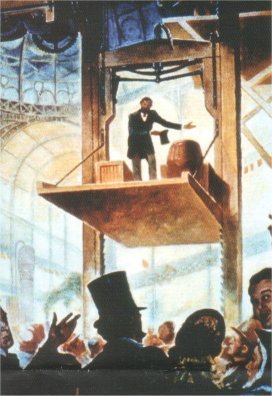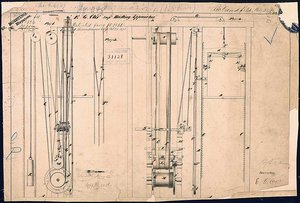Once the steel-frame skeletal skyscraper became widespread, its progress was limited only by the ability to move within it. A 1930 skyscraper study, sponsored by the American Institute of Steel, connects these two important innovations thus:
- It is interesting to note how nearly the curve for structural steel which made the skyscraper possible, is matched by the curve for elevator equipment which made the skyscraper practicable. (1)
People are obviously unwilling to climb more than a few sets of stairs, but that was the only available way to transport themselves in this new vertical urban space before the elevator was invented. This is where Elisha Otis, the next key person in the development of the skyscraper-network stepped in. Otis was a "resourceful Yankee tinkerer and inventor" who developed two key contributions to the skyscraper (2). First, for the early non-electrical elevators, he developed a safety mechanism in which the elevator would be caught on metal teeth protruding from the side of the elevator shaft instead of dangerously plunging to the bottom; his patent is shown below. This allayed the public's fear of deadly elevator crashes. Otis famously demonstrated his device at the 1854 Crystal Palace Exposition in New York, using himself as a test dummy:


Later, in his second great contribution to skyscrapers, Otis' now-famous elevator company solved an important problem concerning electrical elevators in 1903, when it developed a better leveling system that ended the "intricate and tricky landing maneuvers at each floor", which elevator-riders of the time were accustomed to. This allowed electric elevators to technologically win out, significantly speeding up transport within a skyscraper. Once the elevator had been optimized for popular use, it only contributed to the growth of taller and taller skyscrapers. The 1930 skyscraper study emphasizes that elevator technology was very expensive to install and maintain at that early stage of the skyscraper. The authors put forth the following table to show the comparison between elevator cost increase and rentable area increase as buildings got taller. Clearly these ratios became more desirable as a building grew, calling for taller and taller skyscrapers to be built.
(3)
Footnotes:
1. Clark, W.C., and J.L. Kingston. The Skyscraper: A Study in the Economic Height of Modern Office Buildings. New York: American Institute of Steel Construction, Inc., 1930.
2. Douglas, George H.. Skyscrapers: A Social History in America. Jefferson NC: McFarland & Company, Inc., 1996.
3. Clark and Kingston.
